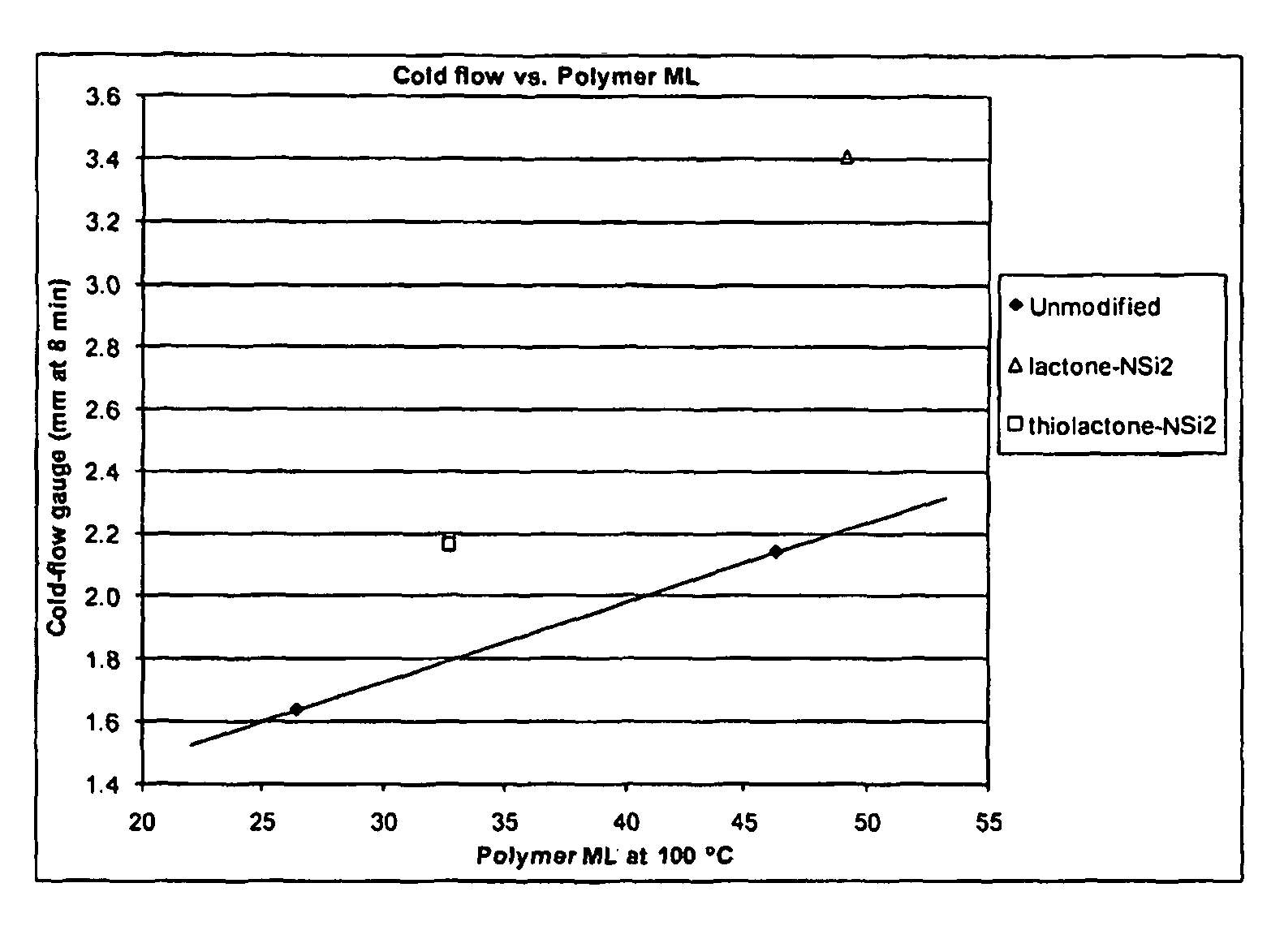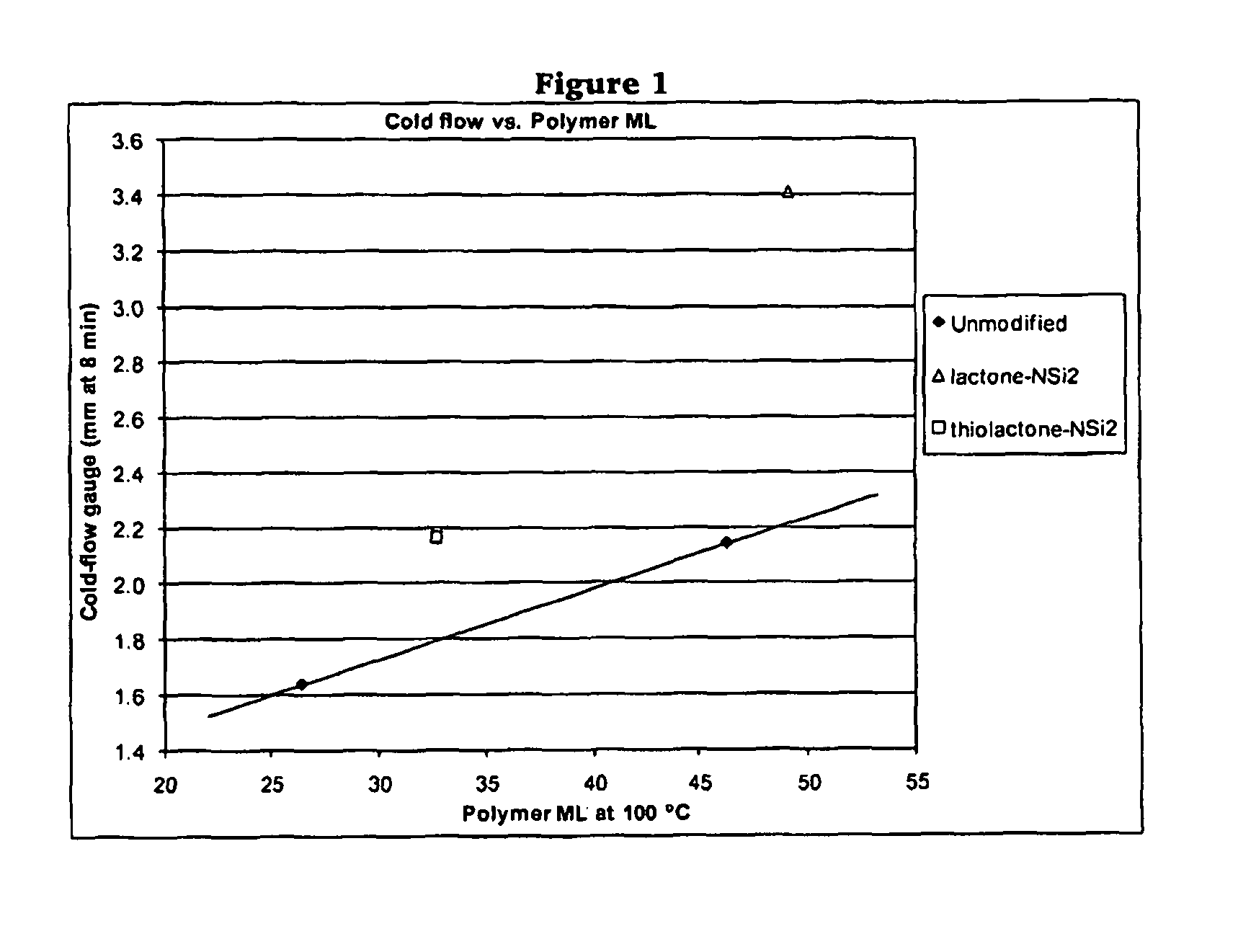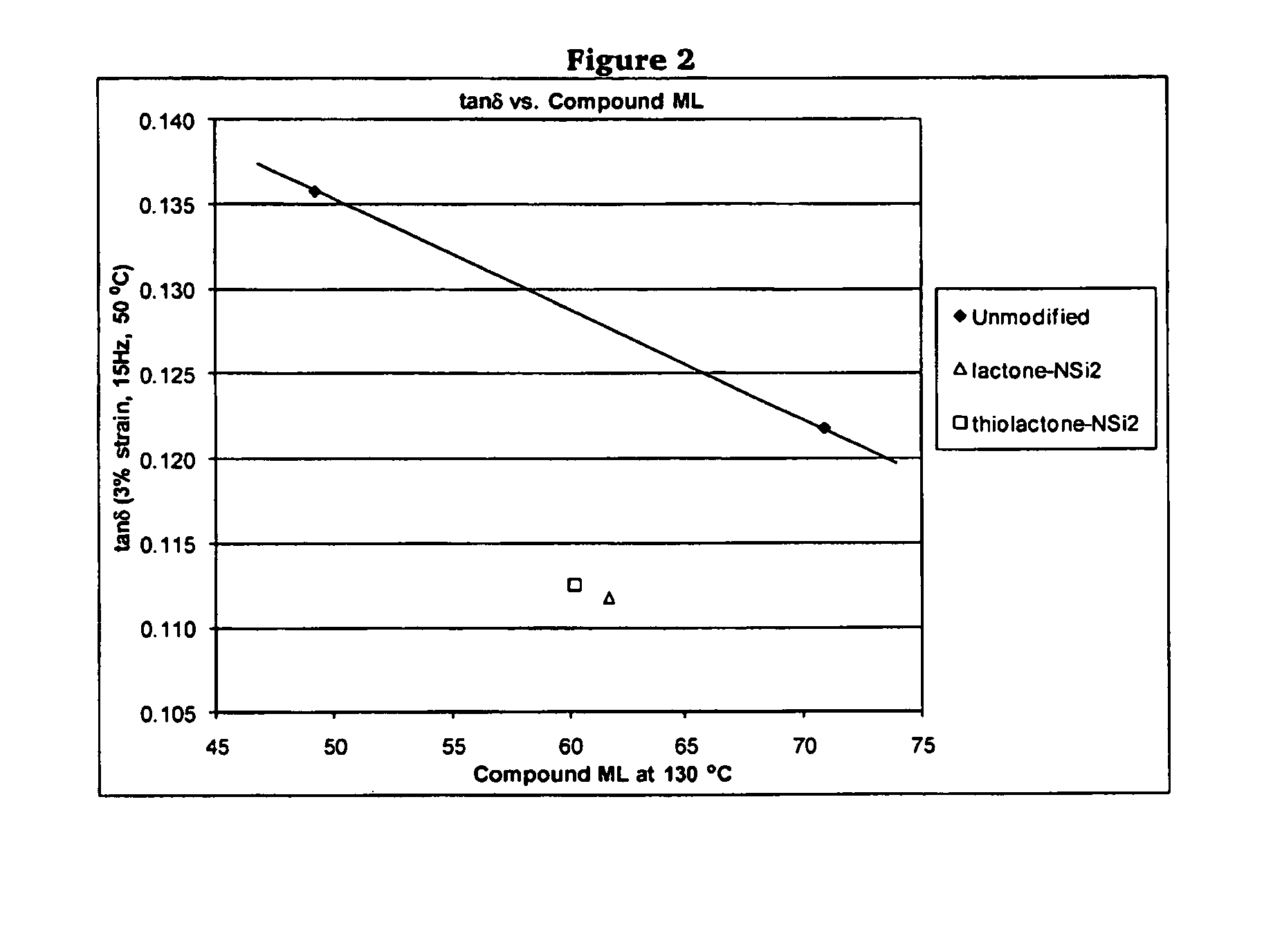Polymers functionalized with lactones or thiolactones containing a protected amino group
a technology of lactones and amino groups, applied in the direction of transportation and packaging, tyre parts, special tyres, etc., can solve the problems of high cold flow due to polymerization, unpredictable whether a reactive polymer can be functionalized by treatment with a particular functionalizing agent, and the inability to meet the requirements of a wide range of functionalization conditions
- Summary
- Abstract
- Description
- Claims
- Application Information
AI Technical Summary
Benefits of technology
Problems solved by technology
Method used
Image
Examples
example 1
Synthesis of α-(2,2,5,5-Tetramethyl-1-aza-2,5-disila-1-cyclopentyl)-γ-butyrolactone (Lactone-NSi2)
[0200]α-Amino-γ-butyrolactone hydrobromide (9.01 g, 0.050 mmol) and dichloromethane (30 ml) were mixed in a round-bottom flask cooled with an ice bath. To this mixture were added triethylamine (16.70 g, 0.165 mmol) and a solution of 1,2-bis(chlorodimethylsilyl)ethane (10.76 g, 0.050 mmol) in dichloromethane (50 ml). The resulting mixture was stirred at room temperature for 47 hours and then evaporated under vacuum. The residue was extracted with 500 ml of cyclohexane and filtered through a frit. The filtrate was evaporated under vacuum, yielding x-(2,2,5,5-tetramethyl-1-aza-2,5-disila-1-cyclopentyl)-γ-butyrolactone (abbreviated to Lactone-NSi2) as a white solid (11.8 g, 97% yield). The 1H NMR data (C6D6, 25° C., referenced to tetramethylsilane) of the product are listed as follows: δ 3.50 (multiplet, 1H), 3.33 (multiplet, 1H), 3.22 (multiplet, 1H), 1.64 (multiplet, 1H), 1.50 (multiplet,...
example 2
Synthesis of α-(2,2,5,5-Tetramethyl-1-aza-2,5-disila-1-cyclopentyl)-γ-butyrothiolactone (Thiolactone-NSi2)
[0202]DL-homocysteine thiolactone hydrochloride (7.68 g, 0.050 mmol) and dichloromethane (30 ml) were mixed in a round-bottom flask cooled with an ice bath. To this mixture were added triethylamine (16.70 g, 0.165 mmol) and a solution of 1,2-bis(chlorodimethylsilyl)ethane (10.76 g, 0.050 mmol) in 50 ml of dichloromethane. The resulting mixture was stirred at room temperature for 47 hours and then evaporated under vacuum. The residue was extracted with 500 ml of cyclohexane and filtered through a frit. The filtrate was evaporated under vacuum, yielding α-(2,2,5,5-tetramethyl-1-aza-2,5-disila-1-cyclopentyl)-γ-butyrothiolactone (abbreviated to Thiolactone-NSi2) as a White solid (11.8 g, 97% yield). The 1H NMR data (C6D6, 25° C., referenced to tetramethylsilane) of the product are listed as follows: δ 3.24 (multiplet, 1H), 2.34 (multiplet, 1H), 2.22 (multiplet, 1H), 1.75 (multiplet,...
example 3
Synthesis of Unmodified cis-1,4-Polybutadiene
[0204]To a 2-gallon nitrogen-purged reactor equipped with turbine agitator blades were added 1646 g of hexane and 2822 g of 22.5 wt % 1,3-butadiene in hexane. A preformed catalyst was prepared by mixing 7.35 ml of 4.32 M methylaluminoxane in toluene, 1.52 g of 22.5 wt % 1,3-butadiene in hexane, 0.59 ml of 0.537 M neodymium versatate in cyclohexane, 6.67 ml of 1.0 M diisobutylaluminum hydride in hexane, and 1.27 ml of 1.0 M diethylaluminum chloride in hexane. The catalyst was aged for 15 minutes and charged into the reactor. The reactor jacket temperature was then set to 65° C. About 60 minutes after addition of the catalyst, the polymerization mixture was cooled to room temperature and quenched with 30 ml of 12 wt % 2,6-di-tert-butyl-4-methylphenol solution in isopropanol. The resulting polymer cement was coagulated with 12 liters of isopropanol containing 5 g of 2,6-di-tert-butyl-4-methylphenol and then drum-dried. The Mooney viscosity (...
PUM
| Property | Measurement | Unit |
|---|---|---|
| temperature | aaaaa | aaaaa |
| temperature | aaaaa | aaaaa |
| temperature | aaaaa | aaaaa |
Abstract
Description
Claims
Application Information
 Login to View More
Login to View More - R&D
- Intellectual Property
- Life Sciences
- Materials
- Tech Scout
- Unparalleled Data Quality
- Higher Quality Content
- 60% Fewer Hallucinations
Browse by: Latest US Patents, China's latest patents, Technical Efficacy Thesaurus, Application Domain, Technology Topic, Popular Technical Reports.
© 2025 PatSnap. All rights reserved.Legal|Privacy policy|Modern Slavery Act Transparency Statement|Sitemap|About US| Contact US: help@patsnap.com



